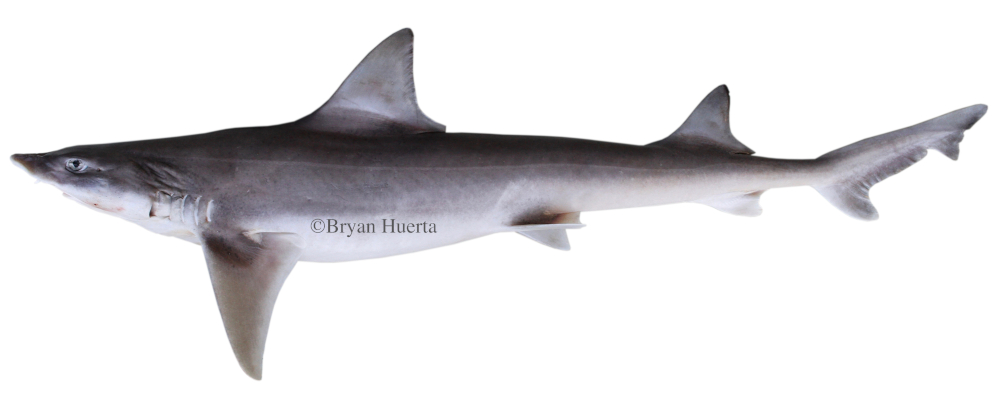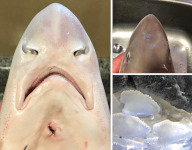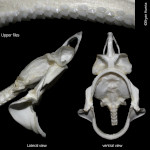Mustelus sinusmexicanus
Heemstra, 1997
Gulf smoothhound
Classification: Elasmobranchii Carcharhiniformes Triakidae
Reference of the original description
A Review of the Smooth-Hound Sharks (Genus Mustelus, Family Triakidae) of the Western Atlantic Ocean, with Descriptions of Two New Species and a New Subspecies. Bulletin of Marine Science, 60(3), 894–928
A Review of the Smooth-Hound Sharks (Genus Mustelus, Family Triakidae) of the Western Atlantic Ocean, with Descriptions of Two New Species and a New Subspecies. Bulletin of Marine Science, 60(3), 894–928
Image of the original description
Image in copyright.
Image in copyright.
Types
Mustelus sinusmexicanus
Holotype: USNM: 208345; Paratype: ANSP: 103925; BMNH: 1972.10.3.3; BMNH: 1972.10.3.4; BMNH: 1972.10.3.2; CAS: 14978; FMNH: 71556; GCRL: 1183; GCRL: 288; MCZ: 35853; SU: 38659; SU: 38660; SU: 38654; TU: 164146; TU: 16544; UF: 230476 (old: UMML 30476); UF: 46038; UF: 27999; UF: 46036; USNM: 116443; USNM: 158585; USNM: 179120;
Mustelus sinusmexicanus
Holotype: USNM: 208345; Paratype: ANSP: 103925; BMNH: 1972.10.3.3; BMNH: 1972.10.3.4; BMNH: 1972.10.3.2; CAS: 14978; FMNH: 71556; GCRL: 1183; GCRL: 288; MCZ: 35853; SU: 38659; SU: 38660; SU: 38654; TU: 164146; TU: 16544; UF: 230476 (old: UMML 30476); UF: 46038; UF: 27999; UF: 46036; USNM: 116443; USNM: 158585; USNM: 179120;
Description :
Citation: Mustelus sinusmexicanus Heemstra, 1997: In: Database of modern sharks, rays and chimaeras, www.shark-references.com, World Wide Web electronic publication, Version 12/2025
Please send your images of "Mustelus sinusmexicanus" to info@shark-references.com

Mustelus sinusmexicanus Heemstra, 1997, northern Gulf of Mexico © Bryan Huerta

Mustelus sinusmexicanus Heemstra, 1997, northern Gulf of Mexico © Bryan Huerta
Common names
 Cazón del Golfo,
Cazón del Golfo,  Gulf smoothhound
Gulf smoothhound
 Cazón del Golfo,
Cazón del Golfo,  Gulf smoothhound
Gulf smoothhound
Short Description
Diagnosis after Heemstra, 1997 [1103]: Caudal fin with prominent, narrowly-rounded ventral lobe, the lobe angle 79°-106° (11 specimens measured). Trailing edges of dorsal fins not frayed. Rear (distal) edge of pectoral and pelvic fins distinctly concave. Head moderate, pre-pectoral distance 17-23% TL; interorbital distance 3.9-4.6% TL; pre-oral snout length 5.4-6.3% TL; inter-nostril distance 2.6-3.3% TL; orbit diameter 2.3-3.1 % TL. Upper-jaw labial folds long (1.9-2.5% TL), distinctly longer than lower-lip folds. Teeth (Fig. 17A) noticeably asymmetric, higher crowned than in most Mustelus, the primary cusp rounded, with a small accessory cusp on posterolateral margin of crown; tooth counts 58-69/60-62. Midlateral flank denticles (Figs. 16b, 17B) distinctly tridentate, strongly sculptured with 3-6 prominent ridges extending to rear margin of scale. Buccopharyngeal cavity (Figs. 18C, 22) almost devoid of denticles; patch of denticles at anterior end of palate not extending posterior to upper lip fold; lingual patch confined to tip of tongue; posterior margin of fifth epibranchial pharyngeal pads with evenly-spaced, denticle-covered, shallow notches (Fig. 22). Palatoquadrate a single cartilage on each side of jaw. Intestine with seven turns in spiral valve. Diagnostic vertebral numbers are given in Figures 23-25. Head and body of adults immaculate grey or greyish-tan dorsally; juveniles usually with sooty smudges on apices of dorsal fins and sometimes on tip of caudal fin.
Diagnosis after Heemstra, 1997 [1103]: Caudal fin with prominent, narrowly-rounded ventral lobe, the lobe angle 79°-106° (11 specimens measured). Trailing edges of dorsal fins not frayed. Rear (distal) edge of pectoral and pelvic fins distinctly concave. Head moderate, pre-pectoral distance 17-23% TL; interorbital distance 3.9-4.6% TL; pre-oral snout length 5.4-6.3% TL; inter-nostril distance 2.6-3.3% TL; orbit diameter 2.3-3.1 % TL. Upper-jaw labial folds long (1.9-2.5% TL), distinctly longer than lower-lip folds. Teeth (Fig. 17A) noticeably asymmetric, higher crowned than in most Mustelus, the primary cusp rounded, with a small accessory cusp on posterolateral margin of crown; tooth counts 58-69/60-62. Midlateral flank denticles (Figs. 16b, 17B) distinctly tridentate, strongly sculptured with 3-6 prominent ridges extending to rear margin of scale. Buccopharyngeal cavity (Figs. 18C, 22) almost devoid of denticles; patch of denticles at anterior end of palate not extending posterior to upper lip fold; lingual patch confined to tip of tongue; posterior margin of fifth epibranchial pharyngeal pads with evenly-spaced, denticle-covered, shallow notches (Fig. 22). Palatoquadrate a single cartilage on each side of jaw. Intestine with seven turns in spiral valve. Diagnostic vertebral numbers are given in Figures 23-25. Head and body of adults immaculate grey or greyish-tan dorsally; juveniles usually with sooty smudges on apices of dorsal fins and sometimes on tip of caudal fin.
Distribution
Western Central Atlantic: apparently endemic to the Gulf of Mexico, from off Panama City, Florida to the Bay of Campeche. Source: www.gbif.org
Western Central Atlantic: apparently endemic to the Gulf of Mexico, from off Panama City, Florida to the Bay of Campeche. Source: www.gbif.org
Remarks
shark-references Species-ID=3822;
shark-references Species-ID=3822;


















